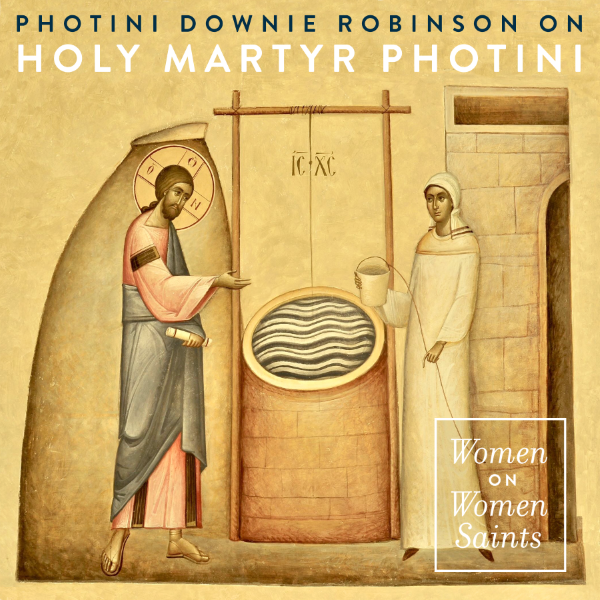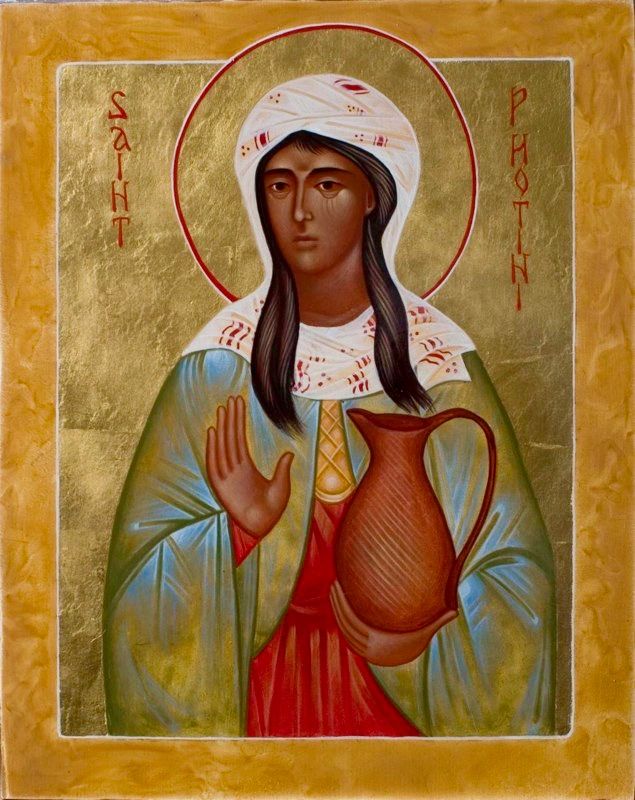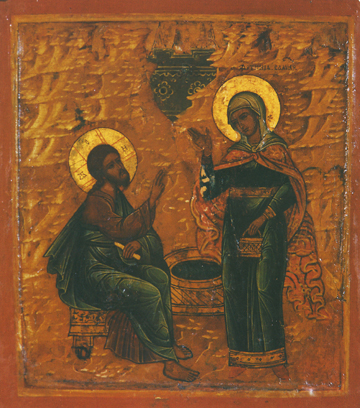
Did you know that the woman at the well, also known as the Samaritan woman, has a name? I was surprised to learn that in Eastern Orthodox hagiography, she was baptized by the apostles with the name Photini, Greek for “luminous one” or “she who is filled with light.” This name is often translated as Svetlana (Slavic), Fatima (Arabic), Fiona (Celtic), or Claire (European). It was a thrill for me to discover that Photini was such an influential figure in the early church. In fact, she is so highly revered that she is said to be “equal to the apostles” in her liturgical rank, a venerable title given to saints whose public witness is comparable to the ministry of Christ’s original disciples.
We meet Photini in the fourth chapter of the Gospel of John. As Jesus and his disciples travel north from Judea to Galilee, they stop for replenishment in Samaria. This is a noteworthy plot point, considering the severe political unrest between Jews and Samaritans in first-century Israel. While Jesus rests by Jacob’s Well at midday, a local woman comes to fill up her pitcher. Having no vessel with which to draw his own water, Jesus asks the woman to give him a drink. This begins a conversation in which Jesus explains that he is the source of the “living water” of everlasting life. He then reveals intimate knowledge of her relationships with a string of men, specifically noting that she and her current man are not married. Perceiving his divinity, the woman abandons her water jug and flees to the city. She soon returns with other Samaritans who share her eagerness to know if this man is really the Messiah.
In my seminary studies, I have been doing a lot of reading about first-century Israel. In this historical context, I recognize the Samaritan woman as the archetype of the poor, disadvantaged, and marginalized. Several intersecting factors would have automatically defined her as a second-class citizen. As a female, she would have had very little social status outside of marriage or kinship; it was considered scandalous for a man to initiate a conversation with a woman outside the familial circle. Secondly, as an unmarried, sexually active woman, she was likely shunned by her community. This could explain why she went to the well at noon, rather than in the cooler hours, to avoid provocation by women with higher social status. Finally, relations between Samaritans and Jews were strained if not downright violent. Photini’s ethno-religious identity would have put her at risk for verbal harassment, physical abuse, or worse. This is made explicit in John 4:9 when she admonishes Jesus: “Jews have no dealings with Samaritans” (NKJV). I am struck by how keenly relevant this still is today. When I am angry, tired, and discouraged, it is easier to dismiss the ‘other’ (“Conservatives have no dealings with Liberals”) than to engage the effort and curiosity required to seek a common humanity.
I find that Photini’s encounter with Jesus provides remarkable insight into contemporary culture. Today’s news channels and social media algorithms are designed to divide us. They are engineered to oversimplify complex issues, to cast nuanced thinking as weakness, and to dehumanize those outside our own echo chambers. In a similarly polarized context, the Jewish man and the Samaritan woman would likely have avoided each other at all costs. And yet, when Jesus invited her to connect, awkward though it must have been, Photini was courageous enough to say yes. After her heart was transformed by Christ’s radical exemplification of love, Photini ran to tell her people. She neither indoctrinated them with dogma nor belittled them for their ignorance. She simply invited them to come see for themselves. It was in this way that she inspired her two sons, five sisters, and hundreds of others to become Christians. She witnessed the martyrdom of her sons and her sisters. Photini herself was martyred in the year 66, cast into a well – a symbolic fulfillment of her mystical union with Christ.


I often look to Photini’s story as a reminder that God meets us in our most vulnerable and unexpected moments. As a female cantor and teacher, I frequently feel like an imposter even in positions of leadership to which I have been appointed by men. On my darkest days, even amid prayerful discernment about my role in the church, I still wonder how I got to this place. Did God really lead me here, or am I conflating God’s agenda with my own? These are the times when I draw courage and inspiration from Photini. When Jesus identifies her with alarming specificity, the divine calling is clear. She neither hides in shame, nor cowers in the shadows cast by those who would call her unworthy. Despite whatever insecurity she may feel, Photini chooses to align herself with God’s will. She embraces the power of her baptism to teach, preach, and lead others radiantly toward Christ. Even the apostles, initially suspicious on account of her ethnicity, gender, and social status, eventually come to recognize (and respect) the inexorable brilliance of the Holy Spirit within her.
Saint Photini is commemorated on the Sunday of the Samaritan Woman, the fifth Sunday of Pascha. Other feast days are February 26 (Byzantine tradition), March 20 (Slavic tradition), and the Great Feast of Theophany (January 6) which is known as the Festival of Lights. Photini is also remembered in the Synaxarion on August 20, the feast of the Holy Prophet Samuel, when we celebrate the discovery of her relics and give thanks for her many posthumous miracles. Holy Martyr Photini, pray for us!
Passionate about the musical traditions of the Eastern Orthodox Church, soprano Photini Downie Robinson is on the forefront of today’s Orthodox music scene as a leader, teacher, and practitioner. She runs a private voice studio, Yphos Music, which is dedicated to the instruction of healthy vocal technique within the context of Byzantine Chant and other types of liturgical music. Photini is the Lambadaria at Holy Trinity Greek Orthodox Cathedral in Portland where she leads the left analogion and chants across from Protopsaltis John Michael Boyer. She is a touring artist with world-renowned vocal ensemble Cappella Romana and also serves on their Board of Directors. She is on the faculty of the Artefact Institute and is always looking for opportunities to learn and collaborate. Photini is one of the leading advocates for integrating women into the classical tradition of the Psaltic Art and is deeply committed to the education, training, and support of all aspiring chanters. A native of the Midwest, she earned her degree in Vocal Performance from the DePauw University School of Music in Indiana. Now based in Portland, Oregon, she has appeared with nearly every professional ensemble in the region including Resonance Ensemble, Portland Baroque Orchestra, Cantores in Ecclesia, Trinity Chamber Singers, Portland Vocal Consort, In Mulieribus, The Ensemble of Oregon, and Third Angle New Music Ensemble


